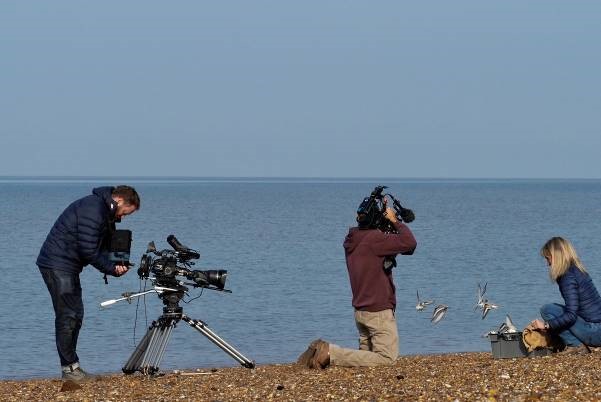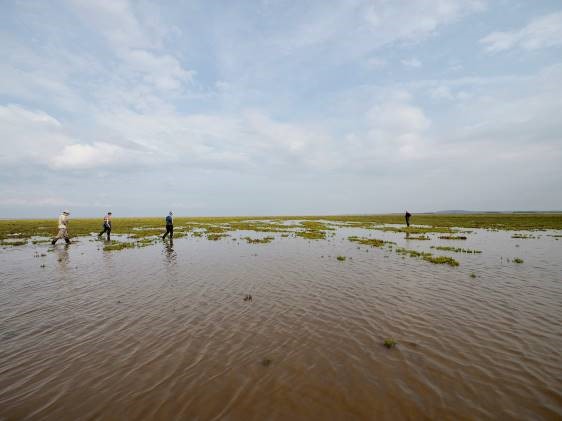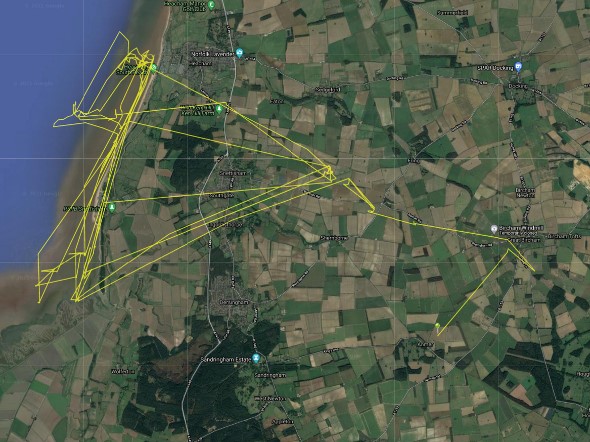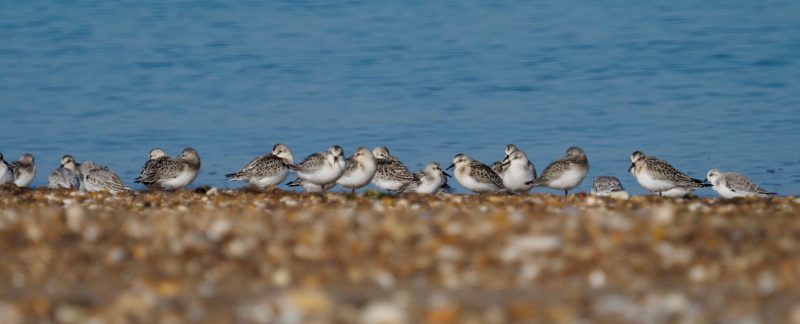Plan for the weekend
This was always going to be a challenging weekend! We had a number of targets and hoped to achieve some of them. The weather forecast was for it to be mild, with light winds, but foggy nights and early mornings.
We had arranged for BBC AutumnWatch to come out and film our work but they could only make the Saturday morning. We had still failed to catch a single Curlew on our east shore study area and had ten GPS/GSM tags to deploy. This is the single largest expenditure on a project that the group had made (£12,000) in its 60-year history so we did not want to have to leave them in a box until next year. We then had an Oystercatcher tag that had already been on two Oystercatchers and had just been found on a beach after the silicone harness had broken (as they are meant to do).
Friday 8 October
Morning recce
Given the need to find a good option to catch curlew and to find a suitable catch for the film crew; Guy, Cathy and Nigel did a dawn recci. Cathy covered the beaches, Guy the Ken Hill fields and Nigel looked at the Sandringham fields.
Early on, Cathy had about 500 Sanderling on Snettisham beach but all but 100 left when they were disturbed by dog walkers. Nigel found a flock of 60 Curlew on the corner of a very rough ploughed field and managed to read four flags and Guy found a flock of about 150 Curlew on Sunnyside field on the northern marsh of Ken Hill.
Considerable discussion was had about which would be the best option for Saturday and Sunday mornings. When we found out that we could not take a vehicle onto the field as it was about to be drilled, our decision was made, as we would only have three people to set and a long carry of the equipment. Cathy’s beach option it was.
Friday evening
Cathy and Ian prepared excellent baked potatoes after which we went to set three nets on the beach. We met the film crew at the beach and decided to set two nets low down to catch birds on the rising tides and one high up to catch at high tide if we needed to. The team and the film crew got on well from the start which gave us confidence that it would all go well if the birds cooperated.
All in bed by midnight, except for Rob who received a message from Elli at 12:15 that she could not find us having driven straight from a catch on Dawlish Warren that morning! Rob went out on the road and guided her in.
Saturday 9 October
Richard was taking the catch and Nigel was with the film crew at the firing position. As it got light there were a handful of Sanderling on the beach but these left and went north. It was not looking very optimistic and then the fog came in making it impossible to see the catching area. The fog lifted a bit and there was a small flock much closer to the firing position than the nets, but it was something to work with. As time went on the fog slowly continued to lift and it was clear the there was several hundred birds on the beach including some Ringed Plovers. The flock was however in net 4 when we had set 3! There was also the small flock next to the firing position. We then proceeded to play a bit of ping pong with the flock until some birds landed in one of the lower nets. The rising tide made it a now or never catch so we fired rather hastily.

Everything went perfectly with an excellent lift in a very calm sea. Nigel and Michaela were filmed running to the nets and Nigel just made it without having to stop! All went very well on a lovely calm, warm and sunny morning perfect for the film crew. There were a few retakes and the upper net was test fired which also enabled the film crew to get some close up shots of the net going out. It was a great morning for the younger members of the team and Michaela went out of her way to talk to Skye and James. James had to do a school project on Hunstanton and decided to do it about ringing birds.
| Species | New | Re-trap | Total |
| Sanderling | 42 | 3 | 45 |
| Ringed Plover | 5 | 0 | 5 |
| Total | 47 | 3 | 50 |
Everybody had been told to take a sandwich as we would be going and setting on a field afterwards for the next morning. While eating our sandwiches Cathy brought out a crumble and custard which was a lovely surprise and fortified the team for carrying the nets out onto the field. A team left for some speed shopping and cooking of a delicious chilli, masterminded by Sara and Sophie. Setting on the field went well but there was not much grot to hide the nets with, so it took a while.
After the return to base, the hope was to get a couple of hours sleep before mist-net setting but there were lots of small jobs to do so the senior people in the team only got five minutes for a cup of tea.
We decided to only mist net on the pool straight out from the white barn as the team was exhausted so seven nets were put in the normal places before the consumption of the chilli and Eton Mess. After dinner we all went down to the white barn and Nigel and David went to put the lures out.
On arrival there were three birds already caught. The two lures were put out and they immediately started catching. After 10 minutes and 15 birds extracted it was decided to call for backup.
By the time that the reinforcements arrived the nets were quite full and there was a light fog. All birds were rapidly extracted, by which time there were few birds flying around even though it was still 45 minutes to high tide. It was decided that one team would take the birds back and the other would take down.
All birds, nets and people were off the marsh before high tide and ringing, processing and colour marking was quite efficient, so we were again in bed before midnight.
| Species | New | Retrap | Total |
| Dunlin | 53 | 0 | 53 |
| Black-tailed Godwit | 8 | 0 | 8 |
| Bar-tailed Godwit | 2 | 0 | 2 |
| Redshank | 38 | 4 | 42 |
| Spotted Redshank | 1 | 0 | 1 |
| Turnstone | 8 | 0 | 8 |
| Knot | 9 | 0 | 9 |
| Total | 119 | 4 | 123 |
Sunday 10 October
One carload was up at 4.45 (again!) the rest having a half hour lie in.
There was some fog on the way, but we got the decoys out before dawn. Once back on the inner seawall it became clear that we could not see the nets clearly from the firing position in the misty conditions. Having walked up and down the sea wall for 10 minutes the nets were fully located by Nigel climbing up on to the top rung of the kissing gate and tying himself on to the finger post for the right of way! Luckily once all the markers were located, he could come down and see from the top of the seawall.
Not long after this a big flock of Curlew came over and landed between the two nets which were set about 70 metres apart! A couple of birds had landed with the outer set of decoys, but these soon wandered out. Sam was despatched to walk up the far side of the field next to the caravan park to try and gently move the Curlew flock into the catching area. When this did not work, she started to do a tractor twinkle with some success. At this point it unexpectedly started to rain and Sam informed us over the radio that she did not have a coat. This coincided with the flock taking off and half flying inland the other half landing 500 m away on the field.
Rob was despatched to see if he could get to the other side of them and the catching team sent to their cars to wait for the rain to stop. As the rain started to get lighter, Rob was activated again. Before he managed to get round the other side of the birds a raptor appeared through the gloom lifting the flock up and out of view in the mist. Suddenly birds started landing near one of the nets and Richard reckoned that we would get eight so we fired as they were definitely all safe. It felt like a very long run to the nets! But those in the cars overtook the wet folk from the firing position and got the birds out ASAP.
We were all elated that we had caught over 10 so that we could fit the 10 GPS/GSM tags that the group had bought, to understand more about the way the Curlew use The Wash and the hinterland during the course of the winter.
Tagging was efficient however inevitably it was slow as once each tag was fitted the bird was put back in a cage to settle before the harness was finished off and the bird released. We learnt a lot form this effort and have plans on how to speed it up in future. While this was happening Phil did a fantastic job of sorting the equipment on the field and getting a lot off. This meant that we only had a single trip out to retrieve the rest of the gear.
| Species | New | Re-trap | Total |
| Curlew | 7 | 5 | 12 |
Back to the base for a breakfast prepared by Cathy to be ready for our return and a relatively quick turn round to get the gear ready for mist netting at Wolferton. One team went to set while Elli took the helm in the Kitchen and cooked a really ‘meaty’ vegetable soup to have on the sea wall.
Nigel had been out on a Recci with Steve, Lizzie and Cathy the previous month, so Nigel said with confidence that you only needed wellies and waterproof trousers. When the setting team went to go out to where we were setting the nets, they found the water in the low patch by the seawall much deeper than expected and difficult to cross due to the poaching of the ground by the cattle grazing the marsh. One person was heard to say ‘when will we ever learn that when Nigel says you only need wellies you are more likely to need chest waders!’ The others agreed – except Nigel. Finding a way across meant that we were very late getting to the pool to set nets and we decided to only put up five ‘French’ nets.

Back to the seawall for soup then back out to the nets with the whole team. On the way out Nigel developed a trapped nerve in the top of his leg making it difficult for him to take any further part in the extraction rounds.
Catching was steady with 10 or so birds per round when an hour before high tide we heard a very large flock of waders forming about 100 metres from the nets. Unfortunately, this coincided with the wind suddenly getting very strong blowing along the line of the nets. This wind was totally unexpected as the weather had been calm up to that point. Fearing that there could be a sudden squall associated with the wind it was decided to send a team back with the birds while the others took down. Nigel took the team off very slowly but they made it back to the seawall safely with the birds.
There were three Oystercatchers amongst the catch and one of them was fitted with a GPS/GSM tag. The first bird which had this tag fitted to it had nested near a White tailed Eagle nest in Norway and was predated by something. Fortunately, the nest was monitored and so the tag was retrieved. The tag was next put on an Oystercatcher in a catch on the Horseshoe in Lincolnshire. The harness broke after two months allowing the tag to fall off and it washed up at Titchwell where it was collected. Let’s hope the third bird keeps it for longer. Ringing and processing was efficient and most of the team left for home as they had commitments the next day (like work!).
| Species | New | Retrap | Total |
| Dunlin | 34 | 1 | 35 |
| Grey Plover | 4 | 0 | 4 |
| Oystercatcher | 3 | 0 | 3 |
| Redshank | 6 | 1 | 7 |
| Knot | 6 | 0 | 6 |
| Bar-tailed Godwit | 7 | 0 | 7 |
| Total | 60 | 2 | 62 |
Monday 11 October
The small team left at the base got up leisurely and then spent a very long time doing all the tidying up from what had been an incredibly hard, but exhilarating, weekend. We achieved all the group’s aims for the weekend and went home to recover. Many thanks to all those who were recruited into the kitchen, often at short notice, which helped make the weekend one to remember for all involved!
The small team left at the base got up leisurely and then spent a very long time doing all the tidying up from what had been an incredibly hard, but exhilarating, weekend. We achieved all the group’s aims for the weekend and went home to recover. Many thanks to all those who were recruited into the kitchen, often at short notice, which helped make the weekend one to remember for all involved!
Re-sighting totals for the weekend:
| Species | Sightings | Individuals | WWRG |
| Curlew | 12 | 12 | 12 |
| Total | 12 | 12 | 12 |
All the resightings were on the Recce on Friday. The team was too busy for the rest of the weekend to get any more!
Tagged birds
The 10 tagged Curlew are already yielding data! All have been checking in data regularly and after an initial period of them staying on the intertidal over the neap tides, the first bird has made forays inland as can be seen from the map below.

Trip report written by Nigel Clark

